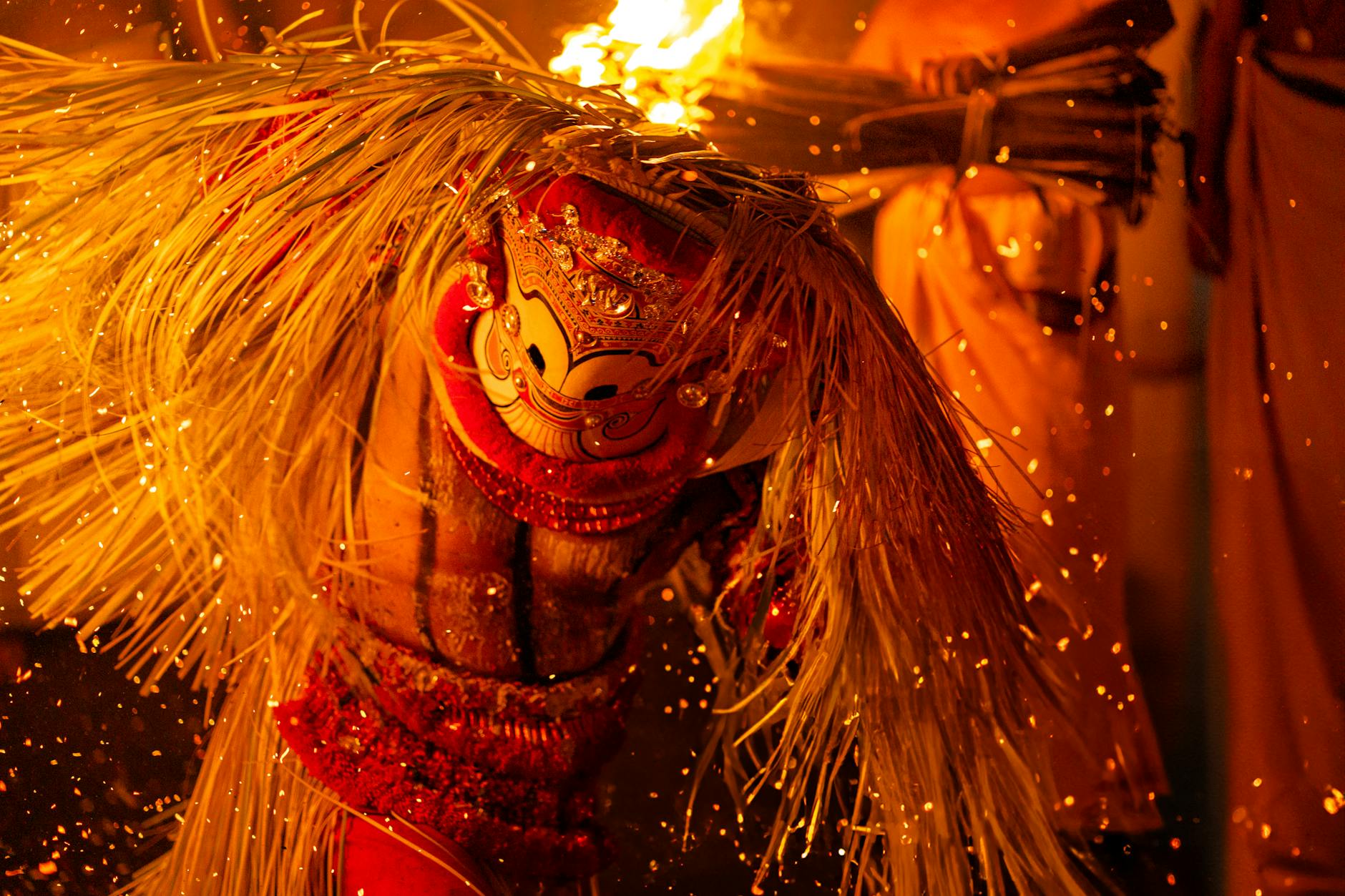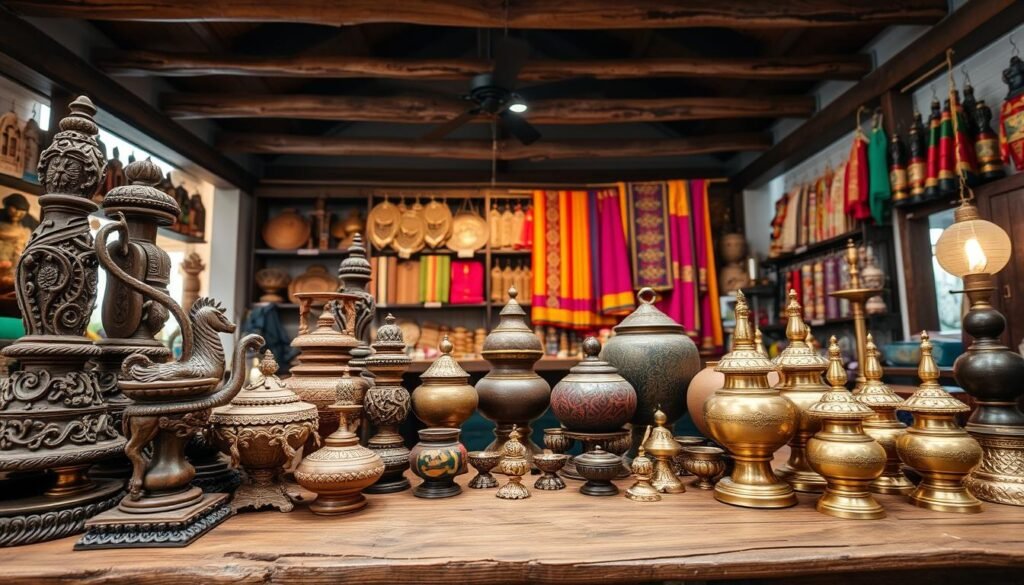Exploring Kerala Traditional Dance Forms: A Glimpse into Cultural Elegance

Step into the enchanting world of Kerala’s traditional dance forms, where every movement tells a story, and every gesture paints a vivid picture of India’s rich cultural tapestry. 🎭💃 Have you ever wondered what it would be like to witness centuries-old traditions come alive before your eyes?
Kerala, known as ‘God’s Own Country,’ is a haven for nature lovers and a treasure trove of artistic expression. Its dance forms, steeped in mythology and folklore, offer a mesmerizing glimpse into the soul of this southern Indian state. From the dramatic facial expressions of Kathakali performances in Kerala to the graceful sways of Mohiniyattam, these dances are a portal to another time and place.
Join us on a visual journey as we unveil the mystical beauty of Kerala’s traditional dance forms. We’ll explore the intricate costumes, elaborate makeup, and powerful narratives that make these performances unforgettable. Whether you’re a dance enthusiast, a culture vulture, or simply curious about India’s artistic heritage, this guide will take you through the rich tapestry of Kerala’s dance traditions, from the world-renowned Kathakali to the lesser-known but equally captivating Theyyam and Koodiyattam. Let’s dive into the vibrant world where art, religion, and tradition intertwine to create magic on stage! 🌟
The Rich Heritage of Kerala’s Dance Forms
Ancient origins and cultural significance
Kerala’s traditional dance forms are deeply rooted in the state’s rich cultural heritage, dating back thousands of years. These classical dance forms are not merely entertainment but serve as a vital link to Kerala’s ancient past, spiritual beliefs, and social customs. The cultural significance of these dances extends beyond mere performance, as they embody the collective wisdom, folklore, and religious traditions of the region.
| Dance Form | Origin Period | Cultural Significance |
|---|---|---|
| Kathakali | 17th century | Storytelling, mythology |
| Mohiniyattam | 16th century | Feminine grace, devotion |
| Theyyam | Ancient times | Ritual worship, folk art |
| Koodiyattam | 2nd century CE | Sanskrit drama, spirituality |
Influence of mythology and folklore
Kerala’s dance forms draw heavily from Hindu mythology and local folklore, weaving intricate tales through graceful movements and expressive gestures. These performances often depict:
- Epic narratives from the Ramayana and Mahabharata
- Stories of deities and their divine interventions
- Local legends and folk tales unique to Kerala
The influence of mythology and folklore not only enriches the artistic value of these dances but also serves as a medium for preserving and transmitting cultural knowledge across generations.
Evolution through centuries
Over the centuries, Kerala’s dance forms have undergone significant evolution, adapting to changing social, cultural, and political landscapes. This evolution is characterized by:
- Refinement of techniques and choreography
- Incorporation of new themes and narratives
- Adaptation to modern staging and presentation methods
- Integration of contemporary elements while preserving traditional core
Despite these changes, the essence of Kerala’s dance forms remains intact, continuing to captivate audiences with their mystical beauty and profound cultural significance.
Kathakali: The Artistic Storytelling through Dance
Elaborate costumes and makeup
Kathakali’s visual splendor is unparalleled, with its intricate costumes and vivid makeup transforming performers into mythical characters. The elaborate attire includes:
- Voluminous skirts
- Ornate headdresses
- Detailed jewelry
The facial makeup, known as “chutti,” is a work of art itself, taking hours to apply. Different colors symbolize various character types:
| Color | Character Type |
|---|---|
| Green | Noble heroes |
| Red | Evil characters |
| Yellow | Sages, women |
| Black | Hunters, demons |
Expressive facial gestures and hand movements
Kathakali’s storytelling prowess lies in its nuanced expressions and precise gestures. Performers use:
- Navarasas (nine emotions) to convey complex feelings
- Mudras (hand gestures) to symbolize objects, actions, and concepts
- Netra abhinaya (eye movements) to enhance emotional depth
These elements combine to create a silent yet powerful narrative, allowing audiences to understand the story without spoken dialogue.
Training and dedication required
Mastering Kathakali demands rigorous training and unwavering dedication. Aspiring performers typically begin their journey at a young age, undergoing intense physical and mental preparation. The training process includes:
- Daily practice sessions lasting several hours
- Rigorous body conditioning exercises
- Extensive study of classical texts and mythologies
This demanding regimen can span over a decade, highlighting the commitment required to excel in this art form.
Famous Kathakali performances and stories
Kathakali draws its narratives from Hindu epics and mythology, bringing timeless tales to life. Some renowned performances include:
- “Nala Charitam” – The story of King Nala and Damayanti
- “Duryodhana Vadham” – The slaying of Duryodhana from the Mahabharata
- “Kalyana Saugandhikam” – Bhima’s quest for the celestial flower
These performances not only showcase the art form’s technical brilliance but also its ability to convey profound philosophical and moral lessons through movement and expression.
Mohiniyattam: The Dance of the Enchantress
Graceful movements and subtle expressions
Mohiniyattam, often referred to as the “dance of the enchantress,” is characterized by its fluid, graceful movements and delicate, nuanced expressions. This classical dance form from Kerala embodies the essence of feminine charm and elegance. The dancer’s body sways gently, mimicking the swaying of palm trees in the coastal breeze, creating a mesmerizing visual rhythm.
Key elements of Mohiniyattam’s graceful movements:
- Soft, circular motions
- Gentle hip swings
- Fluid hand gestures (mudras)
- Subtle footwork
The facial expressions in Mohiniyattam are equally important, conveying a range of emotions with remarkable subtlety. Dancers use their eyes, eyebrows, and slight movements of the lips to portray various feelings, from love and longing to devotion and joy.
Distinctive white and gold costume
The Mohiniyattam costume is as elegant as the dance itself, typically featuring:
| Costume Element | Description |
|---|---|
| Kasavu Saree | White or off-white with gold border |
| Blouse | Matching the saree, with short sleeves |
| Pleats | Neatly arranged fan-like pleats in front |
| Jewelry | Gold ornaments, including necklaces, bangles, and earrings |
This simple yet striking attire enhances the dancer’s movements and complements the gentle nature of the dance form.
Themes of love and devotion
Mohiniyattam performances often revolve around themes of love and devotion, particularly to Lord Krishna. The dance beautifully portrays:
- Romantic love between Radha and Krishna
- Devotional love of a devotee towards the divine
- The concept of Bhakti (devotion) in Hindu philosophy
- Stories from ancient Indian epics and mythology
Through its graceful movements, expressive gestures, and emotive storytelling, Mohiniyattam brings these themes to life, captivating audiences with its ethereal beauty and spiritual depth. As we explore further, we’ll discover how Theyyam, another unique dance form, represents the divine through vibrant rituals and performances.
Theyyam: The Divine Dance of North Kerala
Ritual significance and community involvement
Theyyam, the vibrant ritual art form of North Kerala, holds deep spiritual and cultural significance for the local communities. This ancient tradition serves as a bridge between the divine and human realms, with performers embodying deities during elaborate ceremonies. The entire community actively participates in Theyyam rituals, fostering a sense of unity and shared cultural identity.
| Aspect | Description |
|---|---|
| Performers | Trained artists from specific castes |
| Audience | Entire village community |
| Duration | Can last for hours or even days |
| Venue | Sacred groves or local temples |
Vibrant costumes and face paintings
One of the most striking features of Theyyam is its visually stunning costumes and intricate face paintings. These elaborate outfits and makeup transform the performers into living manifestations of gods and goddesses, creating an awe-inspiring spectacle.
Key elements of Theyyam attire include:
- Vibrant headgear adorned with flowers and intricate designs
- Colorful body paint using natural pigments
- Elaborate facial makeup with bold patterns and symbols
- Ornate accessories such as anklets, bracelets, and necklaces
Trance-like performances and acrobatics
Theyyam performances are characterized by their intense, trance-like nature and impressive acrobatic displays. Performers enter a state of divine possession, executing complex dance movements and stunts that captivate the audience.
Seasonal nature of Theyyam festivals
Theyyam festivals typically occur during the cooler months, from October to May, aligning with the agricultural calendar of North Kerala. This seasonal timing allows for community participation and creates a festive atmosphere that draws visitors from far and wide.
Now that we’ve explored the mesmerizing world of Theyyam, let’s delve into another ancient and revered dance form of Kerala: Koodiyattam, the oldest surviving Sanskrit theatre tradition.
Koodiyattam: The Ancient Sanskrit Theatre
UNESCO recognition as Intangible Cultural Heritage
Koodiyattam, the ancient Sanskrit theatre of Kerala, achieved a significant milestone in 2001 when UNESCO proclaimed it as a Masterpiece of the Oral and Intangible Heritage of Humanity. This recognition not only brought international attention to this unique art form but also emphasized its cultural importance and the need for its preservation.
| UNESCO Recognition | Year | Significance |
|---|---|---|
| Proclamation | 2001 | Masterpiece of Oral and Intangible Heritage |
| Inscription | 2008 | Representative List of Intangible Cultural Heritage |
Elaborate eye and hand movements
One of the most distinctive features of Koodiyattam is its intricate and highly stylized eye and hand movements. These movements, known as ‘Netrabhinaya’ (eye expressions) and ‘Hastabhinaya’ (hand gestures), are crucial in conveying emotions, characters, and narratives.
- Netrabhinaya: Involves precise movements of eyebrows, eyelids, and eyeballs
- Hastabhinaya: Utilizes a complex system of hand gestures called ‘Mudras’
- Facial expressions: Combine with eye and hand movements to create a rich visual language
Extended performances lasting several days
Unlike many modern theatrical performances, Koodiyattam is renowned for its extended duration, often lasting several days or even weeks. This unique aspect allows for:
- In-depth exploration of characters and storylines
- Elaborate costume and makeup preparation
- Ritualistic elements integrated into the performance
These extended performances not only showcase the stamina and dedication of the artists but also provide audiences with an immersive experience into the world of ancient Sanskrit drama. As we move forward, we’ll explore how Kerala is working to preserve these rich dance traditions for future generations.
Preserving Kerala’s Dance Traditions
Role of dance schools and institutions
Dance schools and institutions play a crucial role in preserving Kerala’s traditional dance forms. These institutions serve as the backbone of cultural transmission, ensuring that the ancient art forms are passed down to future generations.
- Key functions of dance schools:
- Training young artists
- Organizing performances
- Conducting research
- Maintaining archives
| Institution | Focus Area | Contribution |
|---|---|---|
| Kerala Kalamandalam | Kathakali, Mohiniyattam | Comprehensive training, research |
| Margi Theatre | Koodiyattam | Preservation, performances |
| Natana Kairali | Koodiyattam, Nangiarkoothu | Documentation, training |
Government initiatives for promotion
The Kerala government has implemented various initiatives to promote and preserve traditional dance forms. These efforts have significantly contributed to the revival and popularization of these art forms.
- Government initiatives:
- Annual cultural festivals
- Financial support for artists
- Inclusion in school curricula
- Establishment of cultural centers
Adapting to modern audiences
To ensure the continued relevance of Kerala’s traditional dance forms, artists and institutions are adapting their presentations to appeal to modern audiences. This delicate balance between tradition and innovation helps keep the art forms alive and engaging.
- Adaptation strategies:
- Incorporating contemporary themes
- Using modern technology in stage productions
- Collaborating with international artists
- Creating fusion performances
International recognition and performances
Kerala’s traditional dance forms have gained significant international recognition, showcasing the state’s rich cultural heritage on global platforms. These international performances not only promote tourism but also foster cultural exchange and appreciation.
- Notable international platforms:
- UNESCO Intangible Cultural Heritage list
- International dance festivals
- Cultural exchange programs
- Performances at prestigious venues worldwide
This global exposure has played a crucial role in preserving and promoting Kerala’s dance traditions, attracting both audiences and aspiring artists from around the world.
Experiencing Kerala’s Dance Forms
Best venues to watch performances
To truly experience Kerala’s traditional dance forms, knowing where to watch them is crucial. Here are some of the best venues:
- Kerala Kathakali Centre, Kochi
- Margi Theatre, Thiruvananthapuram
- Kerala Kalamandalam, Thrissur
- Folklore Museum, Kochi
- Vyloppilli Samskrithi Bhavan, Thiruvananthapuram
| Venue | Speciality | Location |
|---|---|---|
| Kerala Kathakali Centre | Kathakali | Kochi |
| Margi Theatre | Koodiyattam | Thiruvananthapuram |
| Kerala Kalamandalam | Multiple dance forms | Thrissur |
| Folklore Museum | Various traditional arts | Kochi |
| Vyloppilli Samskrithi Bhavan | Mohiniyattam | Thiruvananthapuram |
Festivals showcasing traditional dances
Kerala’s vibrant festivals offer spectacular opportunities to witness these dance forms in their full glory. Some notable festivals include:
- Thrissur Pooram: Features Kathakali performances
- Onam: Showcases various dance forms, including Mohiniyattam
- Theyyam Season: Held in North Kerala from November to May
- Nishagandhi Dance Festival: Annual event in Thiruvananthapuram
Workshops and classes for tourists
For those eager to learn, many institutions offer workshops and classes:
- Kerala Kathakali Centre: Short-term Kathakali courses
- Kalamandalam: In-depth training in various dance forms
- Margi: Koodiyattam workshops
- Natana Kairali: Classes in Mohiniyattam and other classical dances
Photography tips for capturing the essence
To capture the magic of Kerala’s dance forms:
- Use a fast shutter speed to freeze motion
- Focus on facial expressions, especially in Kathakali
- Capture the intricate costumes and makeup
- Experiment with low-light settings for atmospheric shots
- Consider using a zoom lens for close-ups without disturbing performers
Now that you’re equipped with the knowledge of where to watch, when to visit, how to learn, and how to capture these mesmerizing dance forms, you’re ready to embark on an unforgettable cultural journey through Kerala’s rich dance traditions.
Related Read: Kerala Train Travel Tips – Essential Guide for a Smooth Journey

Kerala’s traditional dance forms are a testament to the state’s rich cultural heritage, offering a mesmerizing blend of storytelling, artistry, and spirituality. From the elaborate makeup and costumes of Kathakali to the graceful movements of Mohiniyattam, each dance form paints a vivid picture of Kerala’s history and mythology. The divine rituals of Theyyam and the ancient Sanskrit performances of Koodiyattam further showcase the depth and diversity of these art forms.
As we strive to preserve these invaluable traditions, both locals and visitors must appreciate and support Kerala’s dance forms. By attending performances, participating in workshops, or simply spreading awareness, we can contribute to keeping these art forms alive for future generations. These dances are more than just performances; they are living expressions of history, devotion, and artistic brilliance. Whether you witness the power of Kathakali, the elegance of Mohiniyattam, or the divine energy of Theyyam, each experience leaves a lasting impression. Step into this enchanting world, celebrate Kerala’s cultural heritage, and be a part of its timeless storytelling.











